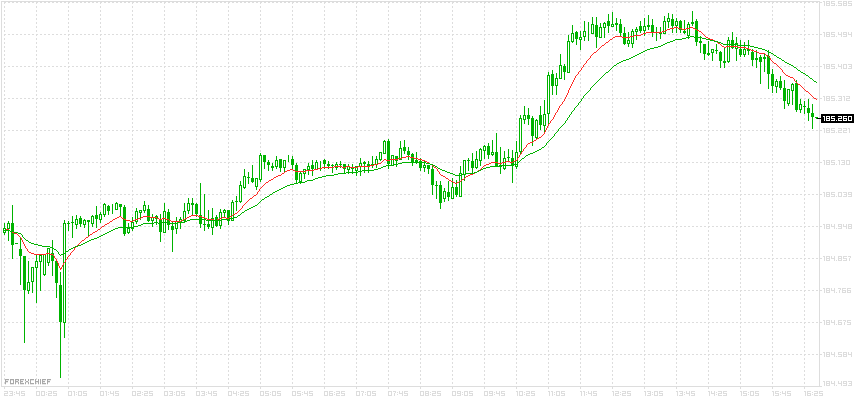กราฟอัตราแลกเปลี่ยนฟอเร็กซ์ CHF/JPY
ราคาอ้างอิง

ฟรังก์สวิส เทียบกับ เงินเยนญี่ปุ่น
CHF/JPY เป็นอัตราแลกเปลี่ยนข้าม (cross rate) ที่อ้างอิงกับดอลลาร์สหรัฐ (USD) ดอลลาร์สหรัฐมีอิทธิพลต่อความเคลื่อนไหวของคู่นี้น้อยกว่าเมื่อเทียบกับยูโร เยนญี่ปุ่น และดัชนีหุ้นในเอเชีย อัตราแลกเปลี่ยนระหว่างฟรังก์สวิสและเยนญี่ปุ่นสะท้อนถึงความสัมพันธ์ระหว่างศูนย์กลางการเงินชั้นนำของยุโรปและเอเชีย ทั้งสวิตเซอร์แลนด์และญี่ปุ่นต้องควบคุมอัตราแลกเปลี่ยนของสกุลเงินประจำชาติของตนอย่างต่อเนื่อง โดยใช้วิธีการทางการเมืองและบางครั้งก็ไม่ใช่วิธีตามกลไกตลาด ทั้งสองประเทศดำเนินการแทรกแซงค่าเงินอย่างสม่ำเสมอ
ด้วยความมั่นคงของมัน ฟรังก์สวิสจึงทำหน้าที่เป็น สินทรัพย์ปลอดภัยระดับโลก (global safe-haven asset) รวมถึงสำหรับผลประโยชน์ทางธุรกิจของเอเชียด้วย คู่สกุลเงิน CHF/JPY มีการตอบสนองอย่างแข็งขันต่อสถานการณ์วิกฤตทางเศรษฐกิจทั่วโลก และมีปฏิกิริยาที่ไวต่อความต้องการเงินเยนที่สูงอย่างต่อเนื่อง ฟรังก์ยังคงมีความเชื่อมโยงอย่างแน่นแฟ้นกับยูโร ดังนั้นพฤติกรรมของมันเมื่อเทียบกับเยนจึงสะท้อนถึงแนวโน้มของคู่สกุลเงิน EUR/JPY ด้วยความล่าช้าเพียงเล็กน้อย สิ่งนี้ทำให้สามารถคาดการณ์แนวโน้มของ CHF/JPY ได้โดยอาศัยกราฟของ EUR/JPY
ปัจจัยต่อไปนี้ส่งผลต่อการคาดการณ์ของ CHF/JPY:
ตัวชี้วัดทางเศรษฐกิจหลักของสวิตเซอร์แลนด์ เขตยูโร และญี่ปุ่น (อัตราคิดลด GDP เงินเฟ้อ อัตราการว่างงาน ดัชนีราคาผู้บริโภค (CPI) ดัชนีผู้จัดการฝ่ายจัดซื้อ (PMI) เป็นต้น)
คำแถลงของเจ้าหน้าที่และสถาบันการเงินของประเทศเหล่านี้ รวมถึงนโยบายการเงินของธนาคารกลางยุโรป (ECB) และธนาคารกลางสหรัฐ (FRS)
การแทรกแซงค่าเงินของเงินเยนญี่ปุ่นและฟรังก์สวิส
ดัชนีตลาดหุ้นเอเชีย (Hang Seng, Nikkei 225, SET50, SSE Composite) ที่มีอิทธิพลต่อเศรษฐกิจญี่ปุ่น
ดัชนีตลาดหุ้นยุโรป (FTSE 100, Swiss Market Index, DAX, CAC 40)
อัตราแลกเปลี่ยนระหว่าง ฟรังก์สวิสและเยนญี่ปุ่น มักได้รับอิทธิพลจากการกระทำของผู้เล่นรายใหญ่ในตลาด และจากหลายปัจจัยที่ไม่เกี่ยวข้องโดยตรงกับสถานการณ์ในสวิตเซอร์แลนด์ ยุโรป หรือญี่ปุ่น ไม่แนะนำคู่สกุลเงินนี้สำหรับผู้เริ่มต้นเทรด คู่เงิน CHF/JPY ถือเป็นสินทรัพย์ที่มีสภาพคล่องต่ำ และอยู่ในอันดับที่หกในแง่ของปริมาณการซื้อขายในช่วงเซสชั่นยุโรป ปริมาณหลักมาจากธุรกรรมแลกเปลี่ยนระหว่างธนาคารกลางของสวิตเซอร์แลนด์และญี่ปุ่น ตลอดจนสัญญาออปชันระยะสั้น
























